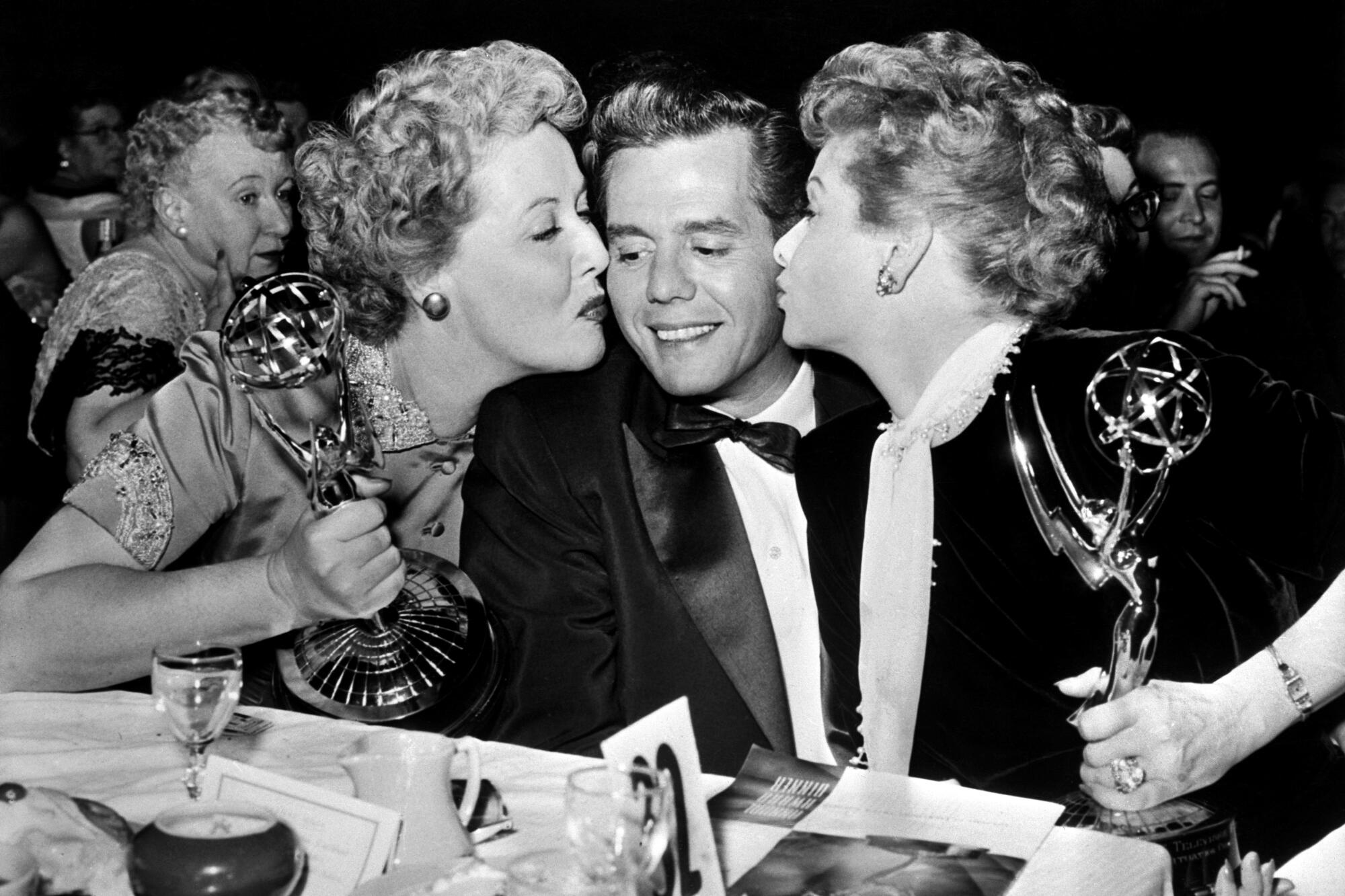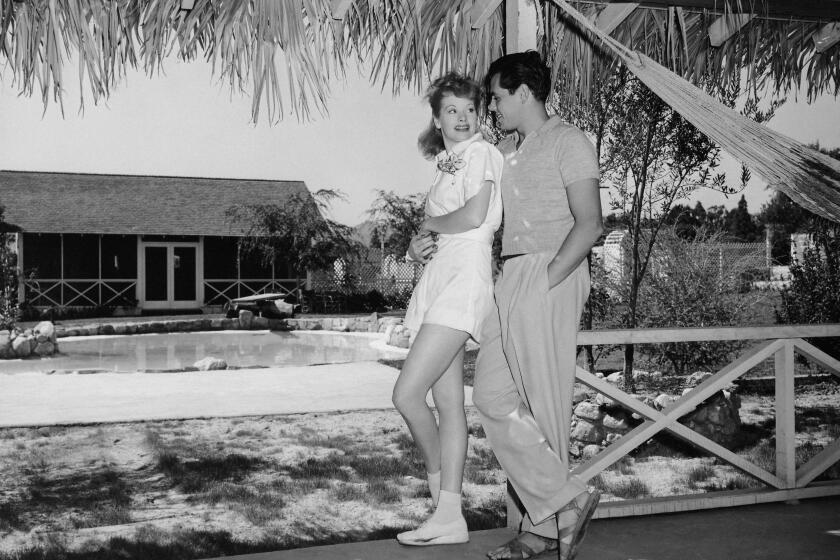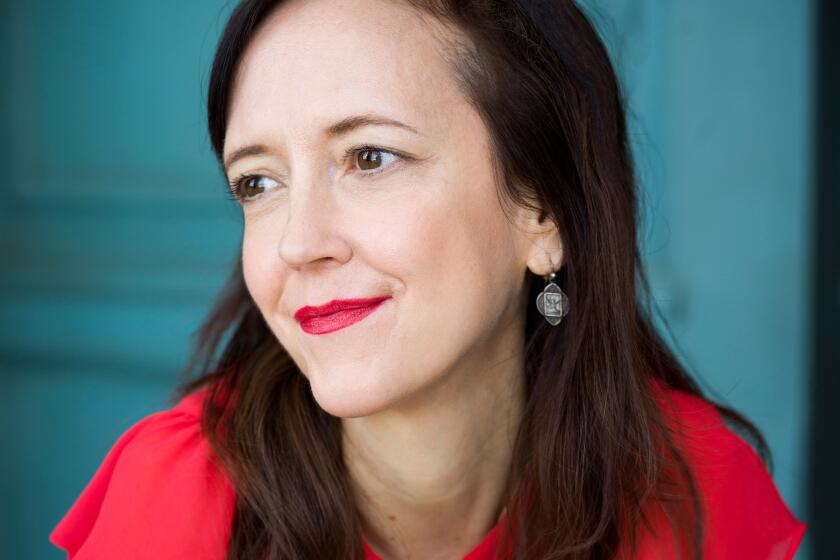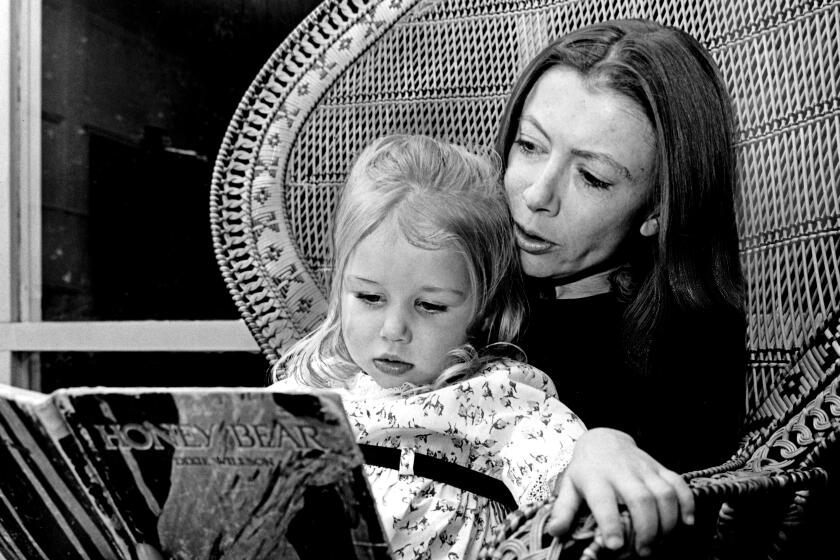
- Share via
Book Review
Desi Arnaz: The Man Who Invented Television
By Todd S. Purdum
Simon & Schuster: 368 pages, $30
If you buy books linked on our site, The Times may earn a commission from Bookshop.org, whose fees support independent bookstores.
Desi Arnaz’s life ricocheted between privilege and economic hardship, creative peaks and alcoholic lows — the stuff of high drama. But it was comedy that secured his legacy. The Cuban American musician, bandleader, actor and producer remains most famous for his role as Lucille Ball’s husband and straight man, Ricky Ricardo, in their iconic 1950s television series, “I Love Lucy.”
Arnaz, playing a version of himself, memorably exploded into exasperation or anger before forgiving the TV Lucy’s slapstick schemes. In actuality, he was far more than his (real-life) wife’s adroit comic foil. As Todd S. Purdum relates in his intimate, often poignant biography, Arnaz was the driving force behind the show and a pioneer of early television.
“I Love Lucy” was filmed before a live studio audience using multiple synchronized cameras, innovations that paved the way for both massively profitable syndication and future sitcoms. That business model, Purdum writes, “lasted unchallenged for the better part of seven decades, until the streaming era established a competing paradigm.” Desilu Productions, the couple’s company, became a leading creator of television content and eventually spawned the “Mission: Impossible” and “Star Trek” franchises.
The themes in “Desi Arnaz” are familiar from Amy Poehler’s 2022 documentary, “Lucy and Desi,” though the book provides more detail and context. Purdum stresses both Arnaz’s underappreciated talents as a producer and showbiz entrepreneur and the couple’s enduring bond, which survived even their divorce and remarriages to others.
“It was really about: What would be a new way in or a way that, creatively, felt like the right thing?” Amy Poehler says of her film about the couple.

Like the film, the biography benefits from the cooperation of the couple’s children, Desi Arnaz Jr. and especially Lucie Arnaz, who opened private family archives to the author. That access allows Purdum (who in 2018 chronicled another creative partnership, between Richard Rodgers and Oscar Hammerstein II, in “Something Wonderful”) to present a nuanced portrait of both Arnaz’s gifts and his tragic shortcomings.
Alongside his celebration of Arnaz’s entrepreneurial savvy, comic flair, photographic memory, personal kindness and managerial skills, Purdum chronicles his (probable) sex addiction and descent into alcoholism. He emphasizes Arnaz’s “compulsive patronage of prostitutes,” which Purdum suggests played an outsize role in his philandering. Whatever the source and specific contours of his demons, Arnaz’s impulsive, self-destructive behavior derailed both his marriage to Ball and his career.
In material terms at least, Arnaz’s childhood in Cuba was idyllic. The privileged only son of an aristocratic lineage, he was “raised as a prince.” His pharmacist father became the reformist mayor of Santiago, and the youthful Desi — born Desiderio Alberto Arnaz y de Acha in 1917 — a bit of a hellion.
But the 1933 Cuban Revolution impelled his family’s flight from the island, dashing Desi’s hopes of a legal career. At 17, he ended up penniless in Miami, living with his father in a rat-infested warehouse and cleaning canary cages for cash. In high school, his best friend was Al Capone Jr., the Chicago mobster’s son.
The radical shift in Arnaz’s fortunes, Purdum argues, led to “a willingness to take bold risks — and a burning, consuming drive to succeed.”
Music was the first path he took. Purdum, otherwise an admirer, describes Arnaz’s musical talents (if not his charisma) as “limited.” Xavier Cugat, “king of the rumba,” nevertheless hired him, and Bing Crosby advocated for him. Arnaz gained celebrity as the American popularizer of the conga, an Afro Cuban line dance that his father had once tried to ban. The Broadway lyricist Lorenz Hart spotted Arnaz in a Miami Beach club called La Conga, and with his collaborator, Richard Rodgers, invited him to audition for their new Broadway musical, “Too Many Girls.”
Arnaz and Lucille Ball, six years his senior and already a movie star, met on the set of the subsequent film adaptation. Their attraction was immediate, mutual and intense. But the relationship was tempestuous from the start. The couple were frequently apart — Arnaz touring with his band, Ball making movies — and they quarreled over his sexual peccadilloes.

“I Love Lucy” originated, in part, as an attempt to save their marriage. By then, Purdum writes, both Arnaz and Ball “had run out their string in the movies and were willing to leap into the still-untested, second-tier medium of television.” The biography offers a fascinating play-by-play of the sitcom’s development.
The show relied on much of the same staff as Ball’s radio hit, “My Favorite Husband,” including head writer Jess Oppenheimer. Oppenheimer, the showrunner for “I Love Lucy” in its early years, remained bitter that Arnaz publicly downplayed his contributions. “Desi had become so used to being underestimated and taken for granted that when it was finally his turn to control the narrative,” Purdum writes, “he sometimes took too much credit.”
Aaron Sorkin’s biopic of Lucille Ball and Desi Arnaz takes some liberties with the truth. We examine the film’s treatment of three real-life events.
Arnaz’s own achievements — as this country’s first Latino television star and television executive — occurred against a cultural backdrop of condescension and outright racism. He also struggled with his insecurities about playing second fiddle to his immensely talented wife. In the end, though, Arnaz’s addictive behaviors were his greatest challenge. He was “often simply too drunk to function,” Purdum writes. Arnaz eventually got sober, but he died of lung cancer in 1986 at 69.
One lifelong friend, Marcella Rabwin, said of Arnaz: “He was a very serious, wonderful man who felt very deeply.” Purdum’s empathetic biography endorses that assessment.
Klein is a cultural reporter and critic in Philadelphia.
More to Read
Sign up for our Book Club newsletter
Get the latest news, events and more from the Los Angeles Times Book Club, and help us get L.A. reading and talking.
You may occasionally receive promotional content from the Los Angeles Times.











